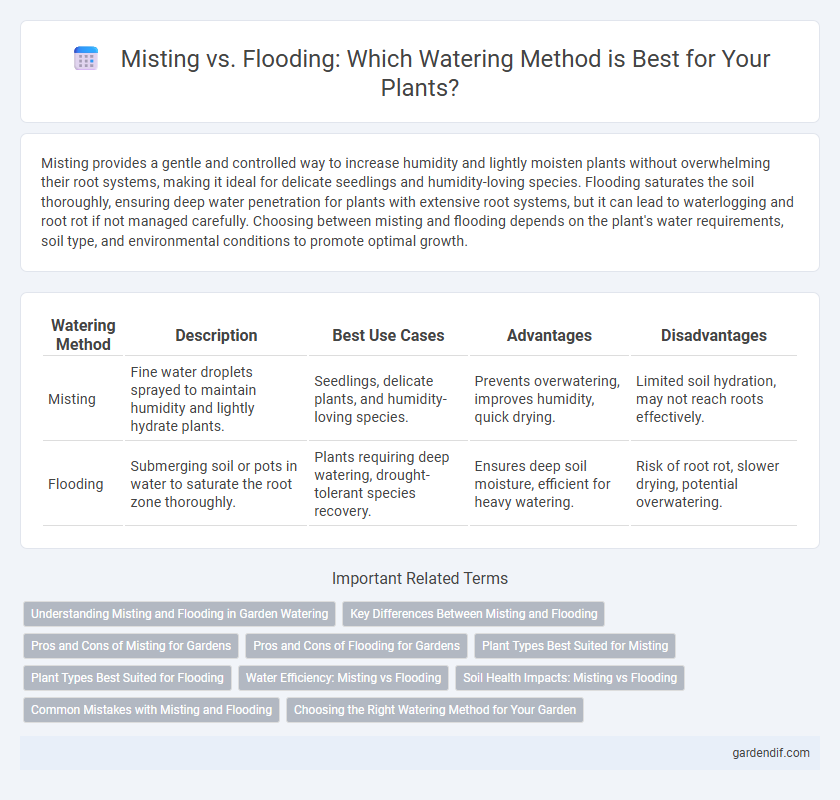
Misting vs Flooding Illustration
Misting provides a gentle and controlled way to increase humidity and lightly moisten plants without overwhelming their root systems, making it ideal for delicate seedlings and humidity-loving species. Flooding saturates the soil thoroughly, ensuring deep water penetration for plants with extensive root systems, but it can lead to waterlogging and root rot if not managed carefully. Choosing between misting and flooding depends on the plant's water requirements, soil type, and environmental conditions to promote optimal growth.
Table of Comparison
| Watering Method | Description | Best Use Cases | Advantages | Disadvantages |
|---|---|---|---|---|
| Misting | Fine water droplets sprayed to maintain humidity and lightly hydrate plants. | Seedlings, delicate plants, and humidity-loving species. | Prevents overwatering, improves humidity, quick drying. | Limited soil hydration, may not reach roots effectively. |
| Flooding | Submerging soil or pots in water to saturate the root zone thoroughly. | Plants requiring deep watering, drought-tolerant species recovery. | Ensures deep soil moisture, efficient for heavy watering. | Risk of root rot, slower drying, potential overwatering. |
Understanding Misting and Flooding in Garden Watering
Misting involves delivering fine water droplets to plants, enhancing humidity and gently hydrating delicate leaves without waterlogging the soil. Flooding saturates the soil by applying large volumes of water, promoting deep root growth but risking overwatering and soil erosion if not managed properly. Choosing between misting and flooding depends on plant type, soil condition, and watering goals to ensure optimal garden health.
Key Differences Between Misting and Flooding
Misting delivers a fine, gentle spray that maintains humidity and provides surface moisture without oversaturating the soil, ideal for delicate plants and seedlings. Flooding involves thoroughly soaking the soil, ensuring deep water penetration to promote root growth but risking waterlogging if overdone. The choice depends on plant type, soil drainage, and moisture requirements, with misting suitable for foliar hydration and flooding aimed at comprehensive root watering.
Pros and Cons of Misting for Gardens
Misting in garden watering provides gentle hydration that minimizes soil erosion and reduces water runoff, making it ideal for delicate plants and seedlings. It promotes increased humidity, which benefits tropical and moisture-loving plants but may also encourage fungal diseases if not properly managed. However, misting requires frequent applications as water evaporates quickly, potentially leading to inconsistent moisture levels compared to more thorough watering methods like flooding.
Pros and Cons of Flooding for Gardens
Flooding in garden watering provides deep soil saturation, promoting robust root growth and ensuring nutrients reach plants efficiently. However, excessive flooding can lead to waterlogging, root rot, and nutrient runoff, negatively impacting garden health. Proper timing and soil drainage are essential to balance the benefits of flooding while minimizing potential damage.
Plant Types Best Suited for Misting
Misting is particularly effective for tropical and epiphytic plants such as orchids, ferns, and air plants, which thrive in high humidity environments without waterlogged soil. Succulents and cacti, adapted to arid climates, may suffer from fungal diseases if subjected to frequent misting. Plants with delicate leaves or those sensitive to overwatering benefit from misting, as it provides moisture directly to foliage without saturating the root zone.
Plant Types Best Suited for Flooding
Flooding is ideal for aquatic and semi-aquatic plants such as water lilies, rice, and lotus, which thrive in consistently saturated soil or standing water. These plants require constant moisture to support their root systems and promote healthy growth. Flooding mimics their natural habitats, ensuring optimal hydration and nutrient absorption.
Water Efficiency: Misting vs Flooding
Misting delivers water in fine droplets, reducing runoff and evaporation, which significantly enhances water efficiency for delicate plants and seedlings. Flooding saturates the soil rapidly but often results in excess water drainage and higher consumption, making it less efficient in water use. Choosing misting minimizes water waste while maintaining adequate moisture levels for optimal plant growth.
Soil Health Impacts: Misting vs Flooding
Misting promotes better soil aeration and maintains optimal moisture levels by delivering fine water droplets that prevent soil compaction and reduce the risk of root rot. Flooding saturates the soil excessively, leading to oxygen deprivation, nutrient leaching, and potential harm to beneficial soil microorganisms essential for plant health. Consistent misting supports a balanced soil microbiome and root environment, contributing to improved overall plant growth compared to the detrimental effects of prolonged flooding.
Common Mistakes with Misting and Flooding
Overwatering by flooding can cause root rot and nutrient leaching, while insufficient misting leads to inadequate humidity and dry foliage. A common mistake with misting is applying it unevenly or infrequently, which fails to maintain consistent moisture levels. Flooding errors often include using poor drainage or watering during peak sunlight, resulting in water stress and plant damage.
Choosing the Right Watering Method for Your Garden
Misting delivers a fine spray ideal for delicate plants and seedlings requiring gentle hydration without waterlogging the soil, promoting healthy leaf respiration and preventing fungal diseases. Flooding saturates the entire root zone, suitable for drought-tolerant or deep-rooted plants needing thorough hydration to encourage robust root growth and nutrient absorption. Selecting the right watering method depends on plant species, soil type, and climate conditions to optimize water efficiency and support plant health.
Misting vs Flooding Infographic

 gardendif.com
gardendif.com